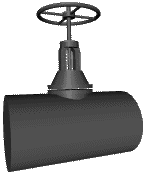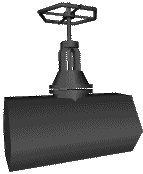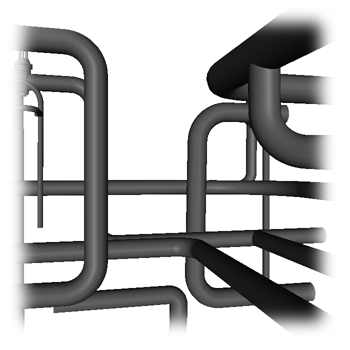The scenes used for visual simulators of complex and hostile
industrial environments, as found in training or project review
applications, are very expensive to render. They contain a large number of
technical networks (piping, cable trays, ventilation) which are usually
modeled by combinations of primitives such as cylinders, tori and cones.
These primitives are converted to triangles at rendering time, leading to a
huge triangle count. In order to maintain a sufficient frame rate, the
resulting meshes must be simplified. Traditionally, this is achieved by
building several levels of details which can be used at different distances
from the observer. Meshes are simplified using polygonal simplification
methods. This technique often proves unsatisfactory for this type of objects
for several reasons the most important being that the topological
relationship between adjacent objects is ignored and discontinuities appear
in rendering.


We have chosen a method of real time adaptive tessellation
of the primitives based on the distance from the viewpoint. In order to
prevent the creation of visual artefacts and ensure a continuity in the
mesh, we describe the relations between primitives by the graph of their
connections. By evaluating the density of points required at each
connection, it is possible to use such a graph to manage the fitting between
the tessellations of the connected primitives. The density of the vertices at
each connection is determined based on the distance from the observer and
the radius of the section, since they both form a good evaluation of the
apparent curvature of the primitive. Based on these numbers, a triangle
strip is dynamically constructed to represent the object. This was
implemented with the OpenGL Optimizer library and coupled with a view
frustum and occlusion culling algorithm so that only visible primitives are
evaluated for dynamic tessellation.
See this EGVE99 article and the relevant
slides for more
information about the algorithm (about the
slides).

The use of levels of details is based on the assumption that
the perception of details varies with the apparent size of the object. While
our adaptive tessellation method provided significant performance gains,
visual perception criteria needed to be evaluated in order to choose
appropriate simplifications levels for the primitives used to represent
technical components of industrial installations. However, we wanted to take
into account higher level visual processes such as identification,
classification or object recognition, and not only consider the perceptual
efficiency of the human visual system. We postulate that further
simplifications can be made which would be perceivable but would not affect
the comprehension and performance in the simulator. We have made the
assumption that workers in the installations (who will be the final users of
our system) have a trade-related knowledge which influences their ability to
recognize the objects.
See this GTRV99 article and the relevant
slides for more
information about the ergonomic experiments
(about the slides).

